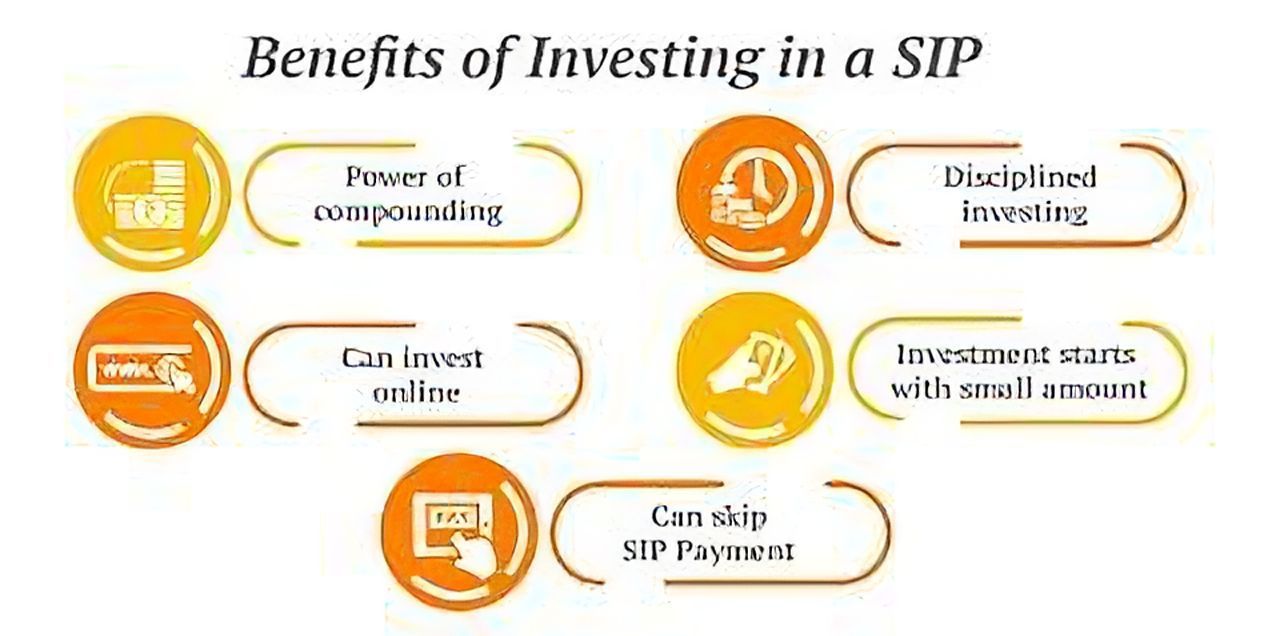Systematic Investment Plan
What is SIP?
Systematic Investment Plan (SIP) allows you to invest in mutual funds in a systematic manner. It is similar to investing in a Recurring Deposit (RD) of a bank. By enrolling for SIP, you commit to invest a fixed sum, at a fixed interval, for a fixed period in a pre-decided fund.
Why SIP?
Investing through SIP is an effective investment strategy as you commit to invest a certain percentage of your “take home salary” and that goes a long way in ensuring that you save as you earn. Moreover, the commitment to invest every month takes emotions out of your decision-making process. These emotions vary from “greed” to “fear” depending upon the state of the stock market, which often makes it difficult to make sound investment decisions. By adopting a disciplined investment approach propagated by SIP, you can benefit from the volatility in the market through “averaging”- investing at different levels of the markets- rather than worrying about it.
However, to benefit from the true potential of this amazing process, there are some Do's and Don’ts to follow:
Do's
The earlier you start, the better: It is crucial to start investing early through SIP as it allows you to invest for a longer period and benefit from “Power of Compounding”.
Remember, delaying your investment can prove very costly.
The values shown are for Illustrative Purposes Only. The assumed return should not be considered as guaranteed return.
As is evident, for someone who delays investing by 10 years, (begins investing at 35 instead of 25), the accumulated corpus would be around 1/3rd of what he could have accumulated (` 6.50 Crores) if he had begun investing at 25. If you haven't started investing through SIP, do it now as it is never too late.
Look beyond traditional options:
If you have been investing a bulk of your money in a Recurring and/or a Fixed Deposit of a bank, it's time for you to look beyond them and invest in mutual funds as they have the potential to offer higher gross as well as post-tax returns. No doubt, being market-linked products, there are attendant risks too. However, by opting to invest in the right asset class i.e. equity, debt or hybrid i.e. a mix of both and appropriate funds coupled with a disciplined approach, you can earn higher post-tax returns. World over, investors have benefitted from investing in mutual funds. It's your turn now!
Align your investments to your goals:
While SIP is a great tool to build a large corpus through smaller contributions over time, it is important to have a purpose for your investment. Some of your investment goals could be buying a house, providing for children's education and marriage, going on a vacation and creating a retirement fund that allows you to retire comfortably.
By defining your goals, assigning a time horizon and target to each one of them, you can work out which asset class to invest in and how much needs to be invested per month to achieve each of the goals. Also, create a separate portfolio for each of your goals rather than creating a pool. This approach will help you in not only monitoring the progress of the portfolio but also in ensuring that you don’t over-or under-deploy funds towards a particular goal.
Assuming that you start planning for your child's higher education at the time of birth, you will have around 18 years to build the corpus required for this important goal of your life. If the current cost of education is Rs.50 lakhs, at an assumed annual inflation rate of 10%, you will require Rs.2.78 Crores when the child turns 18. If you invest in equity funds, you need to invest Rs.36,000 per month thru SIP to achieve this target (at an assumed annualized return of 12%).
Here’s how much you need to invest depending on when you start investing.
Goal: Child's Higher Education
*Inflation rate @ 10%
The values shown are for Illustrative Purposes Only. The assumed return should not be considered as guaranteed return.
Similarly, other long-term goals like child's marriage and retirement planning too requires you to start investing early and in a disciplined manner through your defined time horizon.
Goal: Child's Marriage
*Inflation rate @ 7%
The values shown are for Illustrative Purposes Only. The assumed return should not be considered as guaranteed return.
Goal: Retirement Planning
The values shown are for Illustrative Purposes Only. The assumed return should not be considered as guaranteed return.
Opt For Growth Option:
The power of compounding works out the best when you invest for long-term and allow the gains to remain invested. Taking out money through dividend would defeat the purpose. So, go for growth option.
Don’ts
Don't Invest Randomly: Investing randomly through SIP can prove to be counter-productive. For example, if you decide to invest through SIPs in equity funds only for a year or so and if the market doesn't perform well during this short period, you will be disappointed and could feel compelled to stop investing. Remember, this would be an illogical way of assessing the performance of an asset class like equity and the effectiveness of a powerful mechanism like SIP. So, invest with a clearly defined time horizon and that can be done by aligning your investments to your goals.
Don't Stop SIP in a falling market:
The objective of investing through SIPs is to turn market volatility to your advantage. Therefore, don't stop investing when the markets fall. Remember, those could be the best times for you to invest in the stock market. Therefore, you must continue your investment process for a committed period of time, irrespective of the market mood.
Don't Invest Aggressively Through SIP:
Don't make the mistake of starting an SIP with an amount that you could find tough to continue after a while. So, make a budget to ascertain how much you can begin investing for each of your goals and if there is a shortfall, gradually increase the amount to ensure continuity. If you don't have the money required to be invested for all your goals, the right thing to do would be to prioritize your goals and focus on more important ones.
Don't think you can't lose money:
While investing through SIP will help you tackle the risk of volatility and benefit from it in the longer term, there could be periods where you might see poor/negative short-term returns. However, you must remember that investments made during these periods will help you improve your returns substantially when the market turns around. Hence, keep your focus on long-term results rather than getting distracted by short-term uncertainties.
Don't invest in too many funds:
Investing in too many funds can prove to be counter-productive. By definition, mutual funds are diversified and hence having too many funds in the portfolio could result in over-diversification. Remember, it is always difficult to monitor a portfolio that has large number of funds and that often results in some of the under-performing funds pulling down the overall portfolio returns.
RISK FACTORS: Mutual funds, like securities investments, are subject to market and other risks and there can be no assurance that the scheme's objectives will be achieved. As with any investments in securities, the NAV of units can go up or down depending on the factors and forces affecting capital markets. Please read the offer document before investing.




